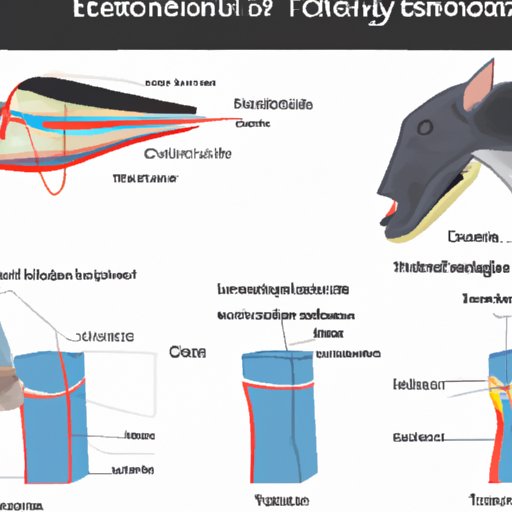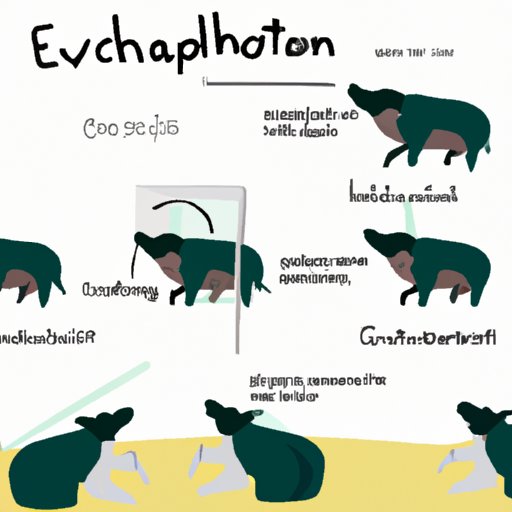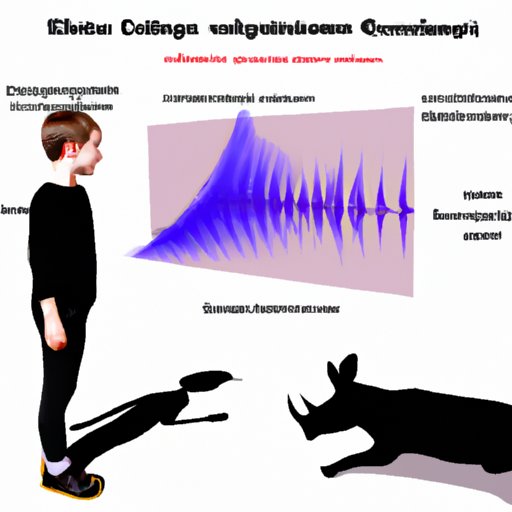Introduction
Echolocation is a remarkable phenomenon that allows animals to navigate their environment and locate prey with incredible precision. This astonishing ability has been observed in many species, including bats, dolphins, whales, and even some birds and fish. But just how does echolocation work? In this article, we’ll explore the anatomy and physiology behind echolocation, examine the benefits it provides for animals, and investigate how scientists are using it to study animal behavior. Plus, we’ll take a look at the potential for humans to use echolocation too.
A. Overview of Echolocation – How It Works
At its core, echolocation is a biological sonar system. The animal produces a sound, usually a high-pitched chirp or whistle, which then bounces off nearby objects. These echoes are picked up by the animal’s ears and interpreted as information about the surrounding environment. Animals using echolocation can “see” in the dark, detect objects that are too small or too far away to be seen by the naked eye, and even distinguish between different types of materials.
B. Examining the Physiology Behind Echolocation
To understand how echolocation works, it’s important to first examine the anatomy and physiology of animals that use it. Most echolocating animals have highly specialized organs and body parts that allow them to produce and receive the necessary sounds. For example, bats have ears that are adapted to pick up ultrasonic frequencies, as well as larynxes that can produce them.

I. Anatomy and Physiology of Echolocation
The anatomy and physiology of echolocation varies among species, but most animals have highly specialized organs and body parts that allow them to produce and receive the necessary sounds. Bats, for example, have ears that are adapted to pick up ultrasonic frequencies, as well as larynxes that can produce them. Dolphins, on the other hand, have an organ known as a “melon” located in the forehead, which helps to focus the sound waves they emit. Whales use their lower jaw as an acoustic lens to focus sound waves, while some birds use their beaks to produce and receive sound.

II. How Animals Use Echolocation
Once the sound waves have been produced and focused, the animal will typically wait for the echo to return before interpreting the information. Depending on the type of material the sound wave hits, the echo will sound differently. For instance, a hard surface such as a rock will reflect the sound back quickly and clearly, while a soft surface like water will absorb the sound and the echo will be less distinct. By distinguishing between different types of echoes, animals can identify the type of material they’re encountering and determine its size and shape.

C. Exploring the Benefits of Echolocation
There are numerous benefits to echolocation. It enables animals to navigate their environment and find food in complete darkness. It also allows them to detect prey that might otherwise be hidden or difficult to spot. Studies have shown that echolocating animals are able to detect objects that are too small or too far away to be seen by the naked eye, and can accurately determine the size, shape, and distance of those objects.
Additionally, echolocation helps animals avoid predators and other dangers in their environment. By emitting sound waves and listening for the resulting echoes, animals can detect whether or not there are any potential threats nearby. This can be especially useful for animals that live in dark or murky environments, where visibility is limited.
D. Investigating Different Animals that Utilize Echolocation
Echolocation is used by a variety of species, including bats, dolphins, whales, and some birds and fish. Let’s take a closer look at each of these species and how they use echolocation.
I. Bats
Bats are perhaps the best-known echolocating animals. They emit high-frequency sound waves and listen for the echoes that bounce back. By interpreting these echoes, bats can detect objects in their environment, even in complete darkness. Studies have shown that bats are capable of detecting objects as small as a single insect.
II. Dolphins
Dolphins are another species that uses echolocation. They emit clicks through their melon organ and listen for the echoes that come back. By interpreting these echoes, dolphins can detect objects in their environment, even in murky waters. They can also use echolocation to communicate with one another and coordinate their movements when hunting prey.
III. Whales
Whales also use echolocation to detect prey and navigate their environment. They emit low-frequency sound waves through their lower jaw and listen for the echoes that come back. By interpreting these echoes, whales can detect objects in their environment, even in deep waters. They can also use echolocation to communicate with one another and coordinate their movements when hunting prey.
IV. Other Animals
In addition to bats, dolphins, and whales, a number of other animals use echolocation, including some birds and fish. These animals emit sound waves and listen for the echoes that come back. By interpreting these echoes, they can detect objects in their environment, even in complete darkness.
E. Comparing Echolocation to Other Animal Sensory Systems
Echolocation is similar to other animal sensory systems such as vision, smell, and hearing. It is most comparable to vision, as both systems involve detecting objects in the environment. However, echolocation has several advantages over vision. For instance, it can be used in total darkness and can detect objects that are too small or too far away to be seen by the naked eye.
F. How Scientists are Using Echolocation to Study Animal Behavior
Scientists are using echolocation to study animal behavior in a variety of ways. For example, researchers are using recordings of echolocation calls to track the movements of bats and dolphins. This allows them to gain insight into the animals’ behavior and habitats. Additionally, scientists are using echolocation to study the impact of human activities on wildlife populations.
For instance, a recent study found that noise pollution from ships has a significant effect on the echolocation calls of dolphins. By analyzing the calls, researchers were able to determine that dolphins living in areas with higher levels of ship noise had altered their calls in order to compensate for the increased noise.

G. Exploring the Potential for Human Use of Echolocation
While echolocation is primarily used by animals, researchers are exploring the potential for humans to use it as well. A number of studies have found that blind and visually impaired individuals can learn to use echolocation to navigate their environment. For example, a recent study found that blind subjects were able to accurately identify objects based on the echoes they heard.
This research suggests that echolocation could provide a viable alternative to traditional aids such as canes and guide dogs. It also opens up the possibility of developing technologies that would enable humans to use echolocation to detect objects in their environment.
Conclusion
Echolocation is an amazing ability used by many animals to navigate their environment and locate prey. By understanding the anatomy and physiology of echolocation, we can better appreciate the benefits it provides for animals, as well as the potential for humans to use it too. As scientists continue to explore the mysteries of echolocation, we may soon unlock even more of its secrets.
(Note: Is this article not meeting your expectations? Do you have knowledge or insights to share? Unlock new opportunities and expand your reach by joining our authors team. Click Registration to join us and share your expertise with our readers.)
